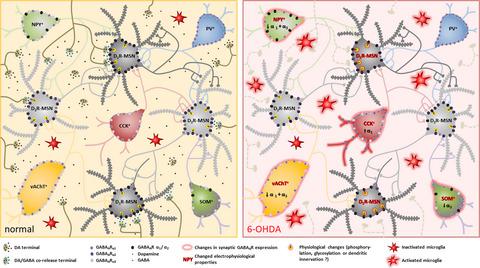当前位置:
X-MOL 学术
›
Eur. J. Nerosci.
›
论文详情
Our official English website, www.x-mol.net, welcomes your feedback! (Note: you will need to create a separate account there.)
Dopamine depletion induces neuron-specific alterations of GABAergic transmission in the mouse striatum.
European Journal of Neroscience ( IF 3.4 ) Pub Date : 2020-06-29 , DOI: 10.1111/ejn.14886 Ida Luisa Boccalaro 1 , Cornelia Schwerdel 1 , Leonardo Cristiá-Lara 1 , Jean-Marc Fritschy 1, 2 , Lena Rubi 1
European Journal of Neroscience ( IF 3.4 ) Pub Date : 2020-06-29 , DOI: 10.1111/ejn.14886 Ida Luisa Boccalaro 1 , Cornelia Schwerdel 1 , Leonardo Cristiá-Lara 1 , Jean-Marc Fritschy 1, 2 , Lena Rubi 1
Affiliation

|
Lack of dopamine (DA) in the striatum and the consequential dysregulation of thalamocortical circuits are major causes of motor impairments in Parkinson's disease. The striatum receives multiple cortical and subcortical afferents. Its role in movement control and motor skills learning is regulated by DA from the nigrostriatal pathway. In Parkinson's disease, DA loss affects striatal network activity and induces a functional imbalance of its output pathways, impairing thalamocortical function. Striatal projection neurons are GABAergic and form two functionally antagonistic pathways: the direct pathway, originating from DA receptor type 1‐expressing medium spiny neurons (D1R‐MSN), and the indirect pathway, from D2R‐MSN. Here, we investigated whether DA depletion in mouse striatum also affects GABAergic function. We recorded GABAergic miniature IPSCs (mIPSC) and tonic inhibition from D1R‐ and D2R‐MSN and used immunohistochemical labeling to study GABAAR function and subcellular distribution in DA‐depleted and control mice. We observed slower decay kinetics and increased tonic inhibition in D1R‐MSN, while D2R‐MSN had increased mIPSC frequency after DA depletion. Perisomatic synapses containing the GABAAR subunits α1 or α2 were not affected, but there was a strong decrease in non‐synaptic GABAARs containing these subunits, suggesting altered receptor trafficking. To broaden these findings, we also investigated GABAARs in GABAergic and cholinergic interneurons and found cell type‐specific alterations in receptor distribution, likely reflecting changes in connectivity. Our results reveal that chronic DA depletion alters striatal GABAergic transmission, thereby affecting cellular and circuit activity. These alterations either result from pathological changes or represent a compensatory mechanism to counteract imbalance of output pathways.
中文翻译:

多巴胺的消耗在小鼠纹状体中诱导神经元特异性GABA能传递的改变。
纹状体中缺乏多巴胺(DA)和随之而来的丘脑皮质回路失调是帕金森氏病运动障碍的主要原因。纹状体接受多个皮质和皮质下传入。它在运动控制和运动技能学习中的作用受黑质纹状体途径的DA调节。在帕金森氏病中,DA损失会影响纹状体网络活动,并导致其输出途径的功能失衡,从而损害丘脑皮质功能。纹状体投射神经元是GABA能的,并形成两个功能拮抗途径:直接途径起源于表达DA受体1的中等棘神经元(D 1 R-MSN),间接途径源自D 2R‐MSN。在这里,我们调查了小鼠纹状体中的DA消耗是否也会影响GABA能功能。我们记录了GABA能级微型IPSC(mIPSC)和D 1 R‐和D 2 R‐MSN的滋补抑制作用,并使用免疫组化标记研究了GABA A R的功能和DA缺失和对照组小鼠的亚细胞分布。我们观察到D 1 R-MSN的衰变动力学较慢,并且对强直抑制作用增强,而D 2 R-MSN在DA耗尽后具有更高的mIPSC频率。含有GABA突触Perisomatic一个R亚基α 1或α 2并没有受到影响,但有在非突触GABA强烈降低甲Rs包含这些亚基,提示受体运输发生改变。为了扩大这些发现,我们还研究了GABA能和胆碱能中间神经元中的GABA A Rs,发现受体分布中细胞类型特定的改变,可能反映了连通性的变化。我们的结果表明,慢性DA耗竭会改变纹状体GABA能传递,从而影响细胞和电路活动。这些改变要么是由病理变化引起的,要么是抵消输出途径失衡的补偿机制。
更新日期:2020-07-30
中文翻译:

多巴胺的消耗在小鼠纹状体中诱导神经元特异性GABA能传递的改变。
纹状体中缺乏多巴胺(DA)和随之而来的丘脑皮质回路失调是帕金森氏病运动障碍的主要原因。纹状体接受多个皮质和皮质下传入。它在运动控制和运动技能学习中的作用受黑质纹状体途径的DA调节。在帕金森氏病中,DA损失会影响纹状体网络活动,并导致其输出途径的功能失衡,从而损害丘脑皮质功能。纹状体投射神经元是GABA能的,并形成两个功能拮抗途径:直接途径起源于表达DA受体1的中等棘神经元(D 1 R-MSN),间接途径源自D 2R‐MSN。在这里,我们调查了小鼠纹状体中的DA消耗是否也会影响GABA能功能。我们记录了GABA能级微型IPSC(mIPSC)和D 1 R‐和D 2 R‐MSN的滋补抑制作用,并使用免疫组化标记研究了GABA A R的功能和DA缺失和对照组小鼠的亚细胞分布。我们观察到D 1 R-MSN的衰变动力学较慢,并且对强直抑制作用增强,而D 2 R-MSN在DA耗尽后具有更高的mIPSC频率。含有GABA突触Perisomatic一个R亚基α 1或α 2并没有受到影响,但有在非突触GABA强烈降低甲Rs包含这些亚基,提示受体运输发生改变。为了扩大这些发现,我们还研究了GABA能和胆碱能中间神经元中的GABA A Rs,发现受体分布中细胞类型特定的改变,可能反映了连通性的变化。我们的结果表明,慢性DA耗竭会改变纹状体GABA能传递,从而影响细胞和电路活动。这些改变要么是由病理变化引起的,要么是抵消输出途径失衡的补偿机制。



























 京公网安备 11010802027423号
京公网安备 11010802027423号